Music
Trailers
DailyVideos
India
Pakistan
Afghanistan
Bangladesh
Srilanka
Nepal
Thailand
StockMarket
Business
Technology
Startup
Trending Videos
Coupons
Football
Search
Download App in Playstore
Download App
Best Collections
Technology
Welcome to the third annual TechCrunch Include Progress Report. Our editorial and events teams work hard throughout the year to ensure that we bring you the most dynamic and diverse group of speakers and judges to our event stages. And finally, at the tail end of 2019, we bring you … 2018 data. (You can see 2017 data here.)
In 2018, TechCrunch produced Disrupts in San Francisco and Berlin, as well as regional Battlefield events in Zug, Switzerland; Lagos, Nigeria; São Paulo, Brazil and Berlin, Germany. We also produced a number of Sessions events, including the increasingly popular Robotics edition, as well as Blockchain and AR/VR.
It is important to us that we foster an environment that reflects the increasingly diverse tech industry. We are pleased to report that we saw an overall increase across the board with regard to inclusion, while still acknowledging that we weren&t yet where we needed to be when it comes to women and people of color across our stages. Happily, 2019 has been even better, and we&ll bring you those numbers soon.
Below we have compiled data from our 2018 events about the makeup of people who appeared as panelists, judges and founders of the Battlefield competitors.
Disrupt
Our flagship conference attracts speakers, judges and Battlefield contestants from all over the world. It serves as a global arena for startups in all stages of development, as well as investors interested in finding their next big investment.
At Disrupt SF in 2018, of the 153 total speakers and judges, 33% were women and 27% were people of color. On the Battlefield stage, of the 22 teams, 36% had female founders. This is up from 29% the year before.
At Disrupt Berlin, of the 56 speakers and judges, 39% were women and 18% were people of color. Of the 12 teams that competed on the Battlefield stage, half the founders were women.
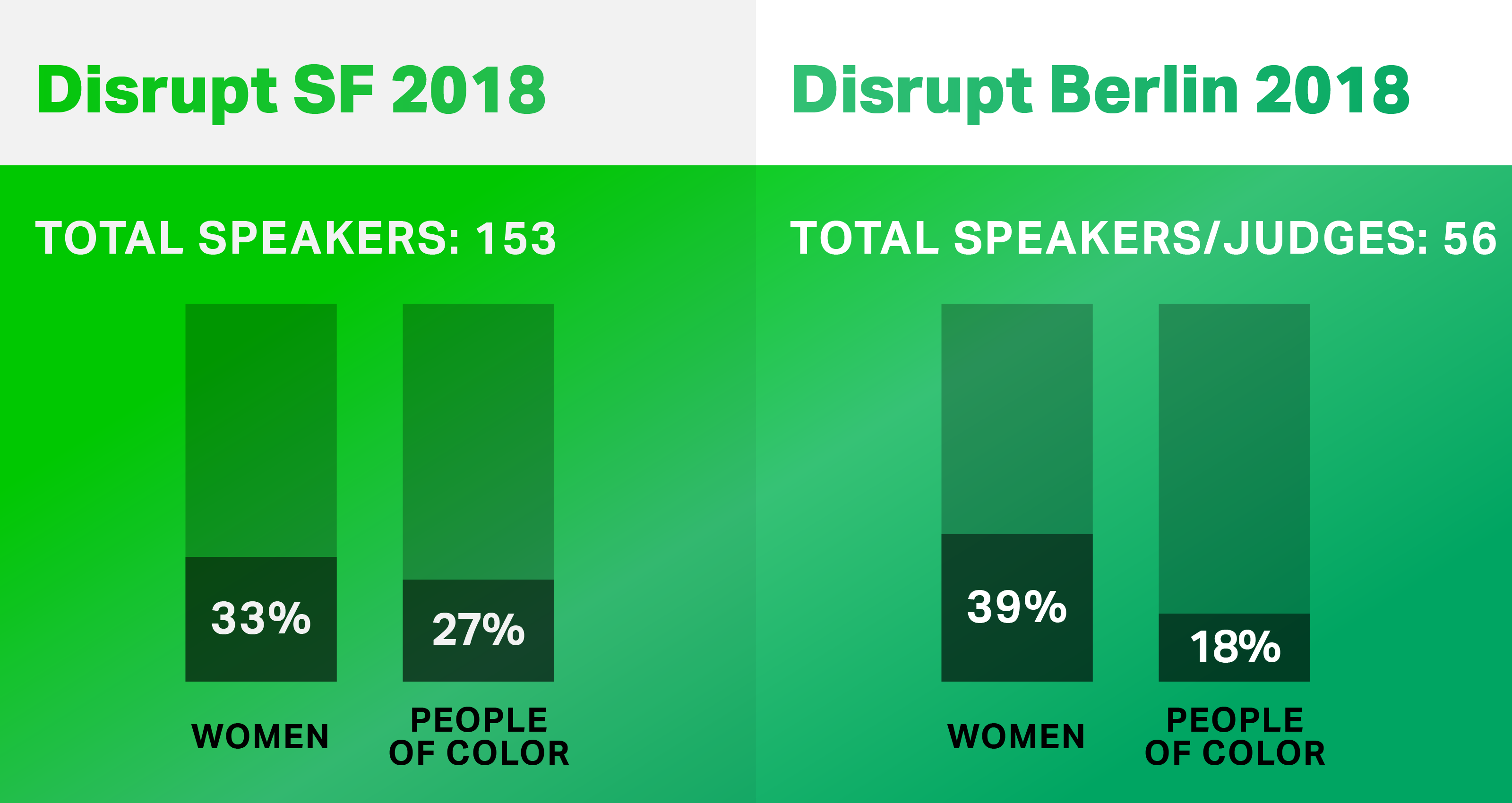
Regional Battlefield
Our Battlefield competition isn&t limited to Disrupt. We take it on the road in order to give as many startups an opportunity to compete. In addition, these events include panels designed around region-specific topics. In 2018, we hosted Battlefield competitions in the Middle East and North Africa, Latin America and Africa regions.
Battlefield MENA showcased 15 teams; of those, 53% were founded by women. Of the 28 speakers and judges, 35% were women and 75% were people of color.
Fifteen teams competed in Battlefield LatAm, 20% of which were led by women. Out of the 28 speakers and judges, 32% were women and 68% were people of color.
And finally, in Battlefield Africa, a total of 15 teams competed. Of those, 33% were founded by women. Of the 28 speakers and judges, 14% were women and 75% were people of color.
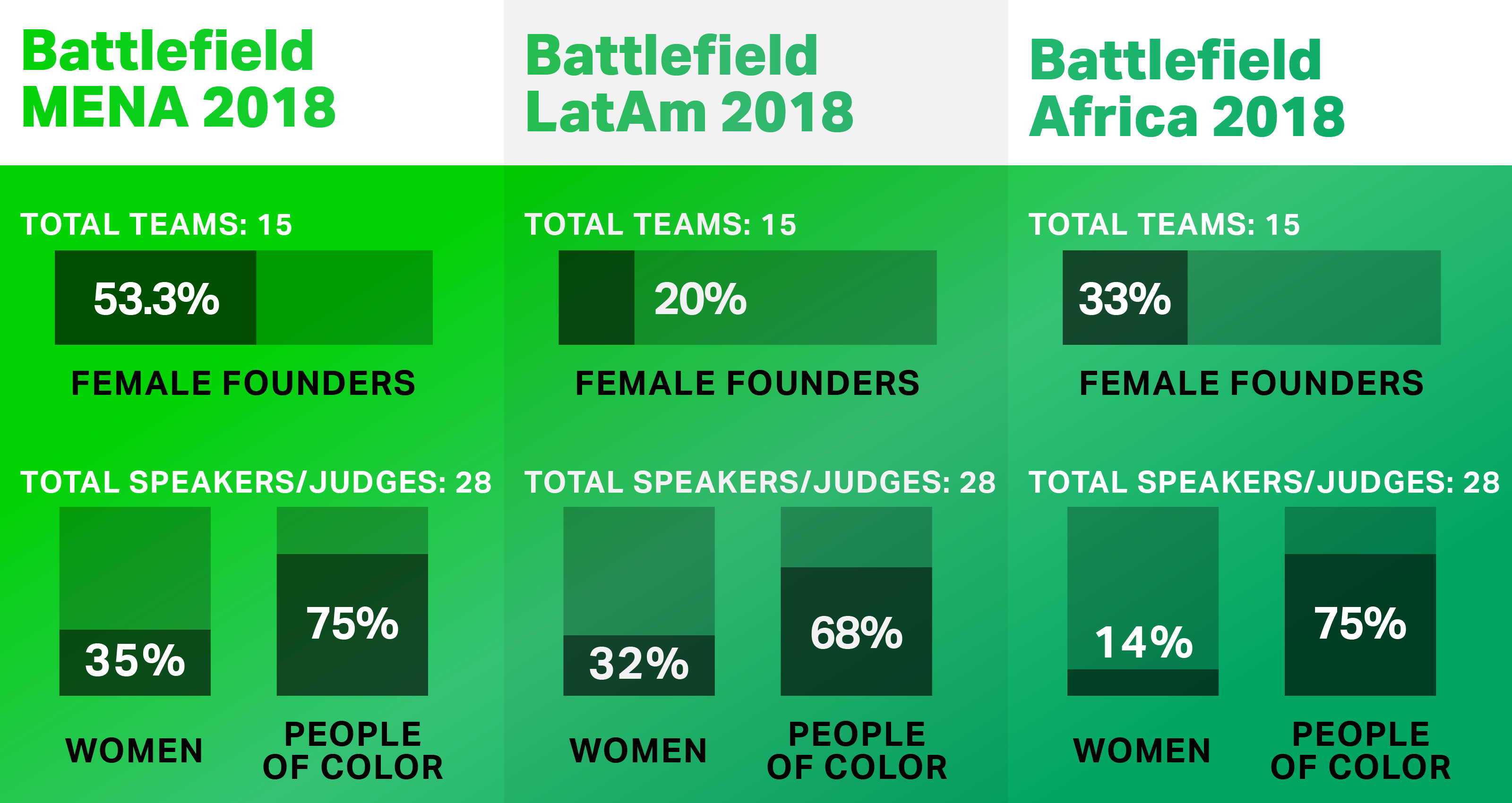
Sessions
Our daylong Sessions events are targeted at specific topics. In 2018, we held events about Blockchain, robotics and AR/VR. TechCrunch Sessions events attract to the stage specialists in their industries speaking to rapt audiences.
Of the 28 speakers who appeared onstage in Berkeley for Sessions: Robotics, 25% were women and 21% were people of color. In Zug, Switzerland for Sessions: Blockchain, of the 29 speakers, 17% were women and 21% were people of color. And in Los Angeles at Sessions: AR/VR, 34% of the 29 speakers were women and 24% were people of color.

Miscellaneous
Tel Aviv
Our event in Tel Aviv leaned heavily toward mobility, and served as a preview of what would become Sessions: Mobility in 2019. Of the 38 speakers in our programming, 21% were women and 63% were people of color.
VivaTech
In 2018, TechCrunch also hosted a hackathon at VivaTech in Paris, as well as presented editorial programming. Of the 20 speakers, 45% were women and 30% were people of color.
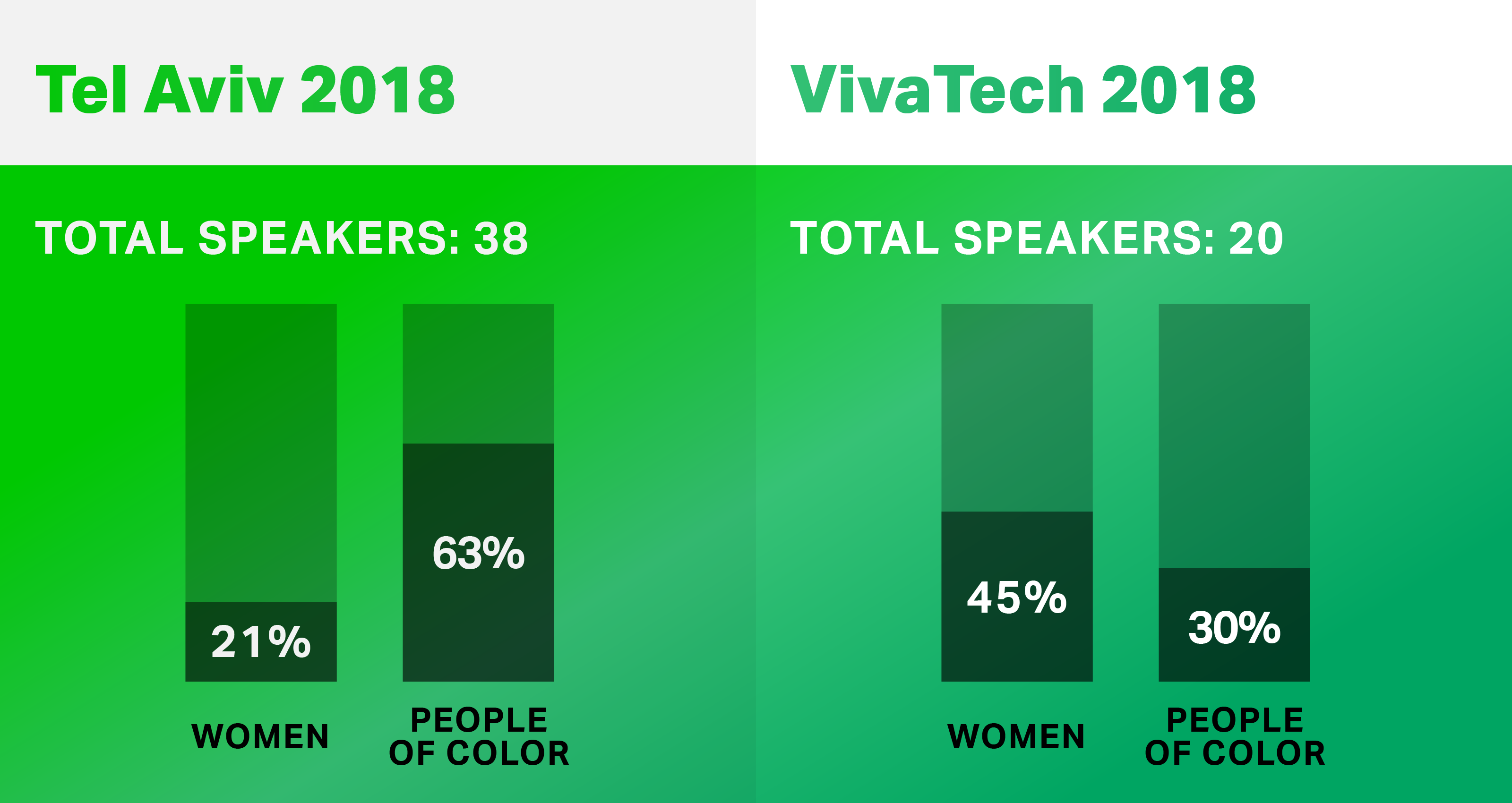
- Details
- Category: Technology
Read more: TechCrunch Include yearly report
Write comment (99 Comments)
The income share agreement (ISA), a financing model where students pay for an education program with a certain percent of their income for several years after graduating, has been one of 2019new buzzwords among VCs and entrepreneurs in Silicon Valley. While still a nascent market that faces regulatory uncertainty in the US and abroad, ISAs are a mainstay of learn-to-code bootcamps and are being piloted at dozens of universities. This financing model is receiving attention because it directly aligns education programs with students& career outcomes — something that could transform parts of higher education.
ISAs will transform the labor market even further though. In the next few years, use of ISAs will likely go beyond formal education programs to create a new category of career accelerators that are more like scaled talent agencies for businesspeople. Across industries and seniority levels, we will see ambitious professionals choose to pay a small percentage of their future income to partner companies that promise to accelerate their careerrise.
Those companies will provide ongoing hard and soft skills trainings, job scouting, guidance on picking the career track and geographic location with the most promise, prep for compensation negotiations, personal branding guidance, and other tactical support like key people to meet and which conferences or private gatherings are most important to target.
This movement will start with graduates of ISA-financed education programs but will quickly expand to other professionals. As career accelerators prove effective at enhancing participants& career prospects, peers of those participants will fear that they are less competitive in the job market without having the advantage of a career accelerator helping them as well.
Outsourcing career guidance
The average annual operating budget for career services departments across US colleges is merely $90,000. For universities, therealmost no support for job placement upon graduation despite the claims of universities in their marketing materials. And theredefinitely no support provided during the years after graduation.
The promise of ISAs is to incentivize higher education programs to design their curriculum with their students& future financial success in mind. Most of the ISA initiatives active right now are either used as a replacement for private student loans at accredited universities or as the financing solution for non-accredited vocational programs (a.k.a. &bootcamps&) that don&t qualify for federal student aid. Their focus remains on curriculum though — ita wholly different activity to focus on guiding graduates in their careers for years afterward.
- Details
- Category: Technology
Read more: How income share agreements will spark the rise of career accelerators
Write comment (96 Comments)2019 was the year wireless earbuds went mainstream. The category has been around much longer, of course, and Apple really broke the whole thing open a full three years ago with the release of the first AirPods, but sales exploded in 2019. The category experienced a 183% YOY increase in shipments last quarter, according to a new study.
The space continues to be driven by Apple, which currently controls 43% of the market (a number that will likely increase with the arrival of the AirPod Pros), but its near future seems destined to be defined by a race to the bottom. With Apple, Samsung, Sony and Google battling it out for the high end of the market, other players are determined to undercut the competition on price.
At $30, JLabGo Air True Wireless Earbuds (the first and last time I&m going to type that full name) are positioned right around Xiaomicategory-defining AirDots. The Chinese manufacturer controls around 7% of the market (a notch above Samsungmore premium offerings), and it seems well-positioned to repeat its fitness band market share success with such offerings.
So, where does that leave JLab? Well, therea lot of market to be had. As more phone manufacturers eschew headphone jacks on even mid-range handsets, therebound to be a rush on low-price wireless earbuds. The Go Air are, well, nothing if not that. Price is their defining characteristic. And honestly, thatfine.
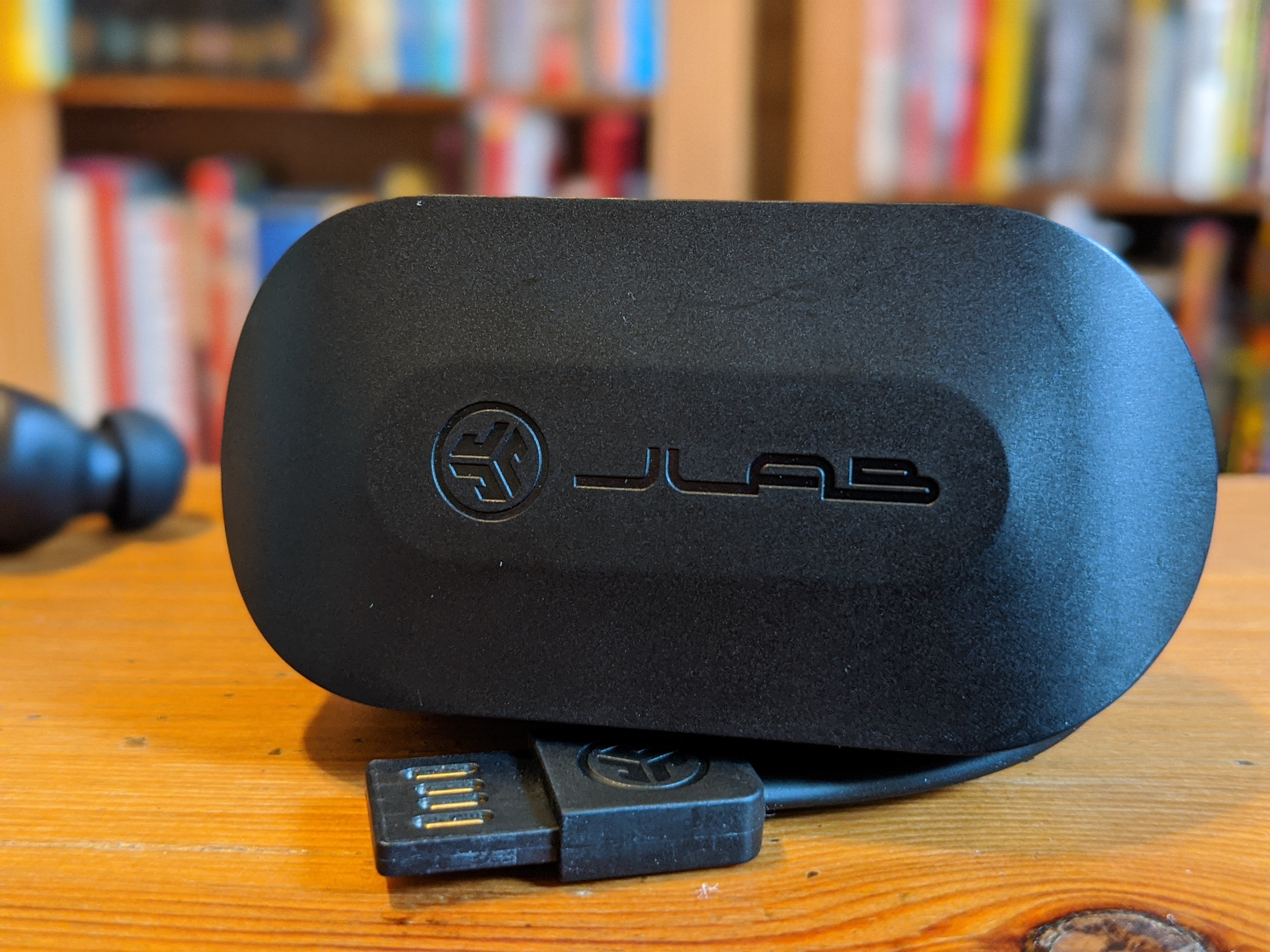
Herethe thing: I&ve been walking around with the AirPods Pro in my ears for a while now. I was less hot on the original AirPods, but these really feel like the category done right. But itnot fair to any party involved to compare the two. You can buy eight and a third pairs of these for the price of the Pros. Different price points, different markets, different consumers.
And while ittrue that JLab has already gone a ways toward saturating the market with different models, low cost is the defining characteristic. The company claims to be the top manufacturer of sub-$100 wireless earbuds in the U.S. And the Go Airs are the lowest of the low. On paper, itcertainly a good deal. The earbuds are light, get five hours on a charge (plus 15 from the case) and are sweat resistant.
I&ve only been playing around with them for the day, and I&ve got a smattering of complaints. The sound isn&t what you would deem &good.& In fact, they&re pretty reminiscent of that $10 pair of earbuds you bought at Walgreens in a pinch. The earbuds and the charging case both feel cheap (and I certainly can&t speak to how long they&ll last), while a USB C or even microUSB port has been traded for a half-USB connector dongle.
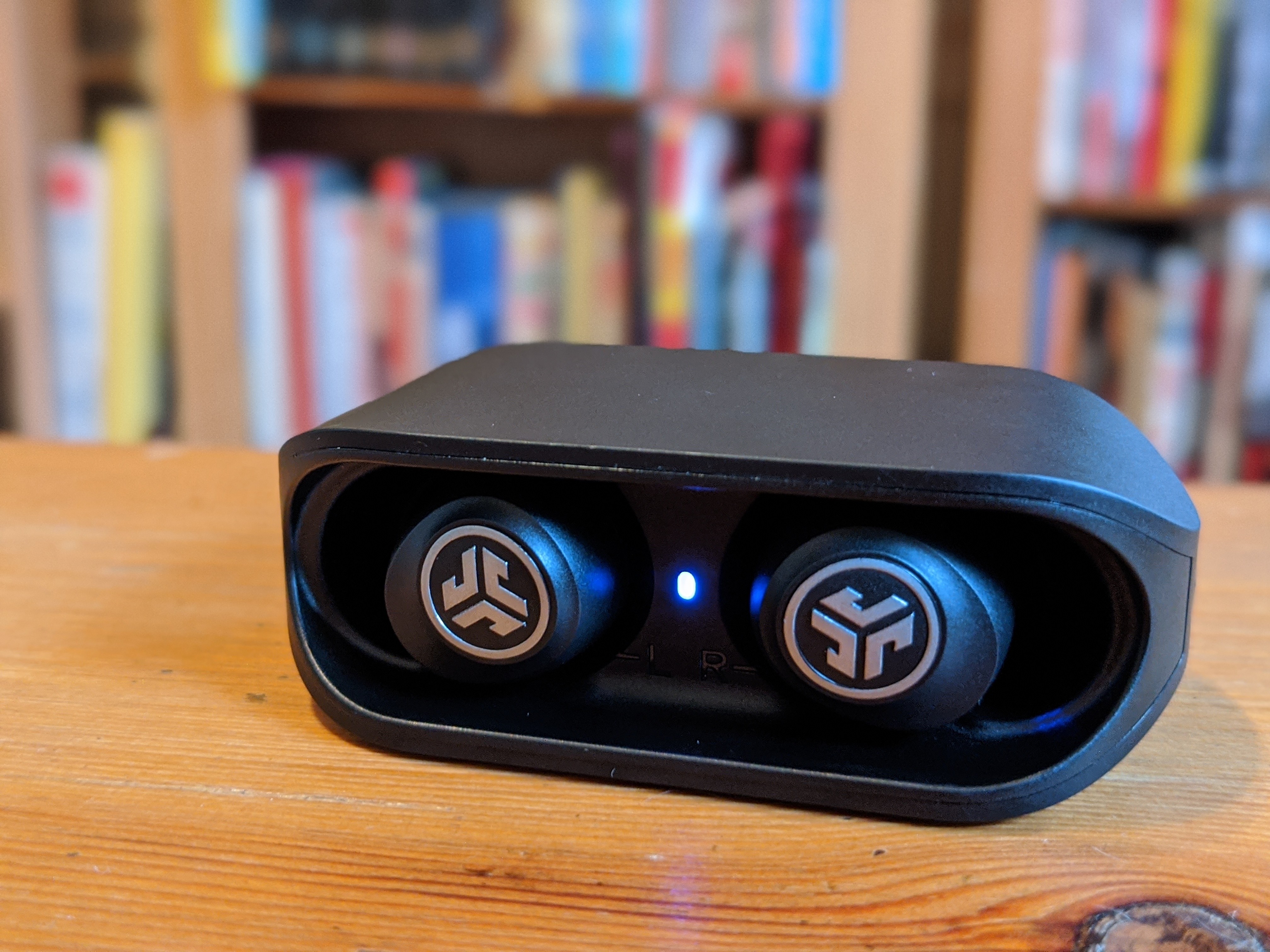
Also, unlike most models, the earbuds don&t automatically shut off when they leave your ears. Though that might be more feature than bug for some. Mostly, you just have to remember to pause playback on your phone. The headphones can operate independently of one another, so you can keep one bud in at a time.
Honestly, any quibble I have here comes with the giant, red-lettered caveat that the things are only $30. If nothing else, it shows how quickly such products have gone from luxury to commodity. Itkind of crazy, honestly. If you want premium headphones, look elsewhere, obviously. For something serviceable and more than anything, cheap, the Go Airs scratch that itch.
They&ll hit retail in March.
- Details
- Category: Technology
Read more: Can a $30 pair of wireless earbuds actually be any good
Write comment (90 Comments)Hello and welcome back to our regular morning look at private companies, public markets and the gray space in between.
Today, the last day of 2019, we&re taking a second look at Boston. Regular readers of this column will recall that we recently took a peek at Bostonstartup ecosystem, and that we compiled a short countdown of the largest rounds that took place this year in Utah. Today we&re doing the latter with the former.
What follows is a countdown of Bostonseven largest venture rounds from the year, including details concerning what the company does and who backed it. We&re also taking a shot after each entry at where we think the companies are on the path to going public.
As before, we&re using Crunchbase data for this project (here). And we&re only looking at venture rounds, so no post-IPO action, no grants, no secondaries, no debt, and no private equity-style buyouts.
Ready? Lethave some fun.
Countdown
Boston has produced a number of big exits in recent years, like Carbon BlackIPO, DraftKings& impending kinda-IPO, Cayanbillion-dollar exit, and SimpliVityhuge sale to HP. Despite that, however, Boston is often pigeon-holed as a biotech hotbed with little technology that folks from San Francisco can understand. Thatnot really fair, it turns out. Thereplenty of SaaS in Boston.
As you read the list, keep tabs on what percent of the companies included you were already familiar with. These are startups that will to take up more and more media attention as they march towards the public markets. Itbetter to know them now than later.
Following the pattern set with Utah, we&ll start at the smallest round of our group and then count up to the largest.
7. Motif FoodWorks& $90 million Series A
We could actually call the Motif FoodWorks‘ Series A a $117.5 million round as it came in two parts. However, the first tranche was $90 million total and landed in 2019 so thatour selection for the uses of this post. The company is backed by Fonterra Ventures, Louis Dreyfus Corp, and General Atlantic.
Motif works in the alternative food space, creating things like fake meat and alt-dairy. Given the meteoric rise of Beyond Meat and Impossible Foodbig year, the space is hot. Lots of folks want to eat less meat for ethical or ecological reasons (often the two intertwine). That demand is powering a number of companies forward. Motif is riding a powerful wave.
The companyknown raised capital is encompassed in a large, early-stage round. That means that we won&t see an S-1 from this company for a long, long time.
6. Klaviyo$150 million Series B
An email marketing and analytics company, Klaviyo gets point for having a pricing page that actually makes sense — a rarity in the enterprise software world.
The Boston-based company was founded in 2012 and, according to Crunchbase data, has raised a total of $158.5 million. It raised just $8.5 million in total (across a small Seed round and a modest Series A) before its mega-round. How did it manage to raise such an enormous infusion in one go? As TechCrunch reported when the round was announced in April of this year:
The company is growing in leaps and bounds. It currently has 12,000 customers. To put that into perspective, it had just 1,000 at the end of 2016 and 5,000 at the end of 2017.
That will get the attention of anyone with a checkbook. The Summit Partners and Astral Capital-backed company has huge capital reserves for what we presume is the first time in its life. That means itnot going public any time soon, even if our back-of-the-napkin math puts it comfortably over the $100 million ARR mark (warning: estimates were used in the creation of that number).
5. ezCater$150 million Series D
ezCater is an online catering marketplace. Thatan attractive business, it turns out, as evinced by the Boston companyfunding history. The startup has raised over $300 million to date according to Crunchbase, including capital from Insight Partners, ICONIQ Capital, Wellington Management, GIC, and Lightspeed.
The company2019 $150 million Series D-1 that valued the company at $1.25 billion wasn&t its only nine-figure round; ezCater2018 Series D was also over the mark, weighing in at $100 million.
When might the Northeast unicorn go public? An interview earlier this year put 2021 on the map as a target for the startup. Thatages away from now, sadly, as I&d love to know how the companygross margin have changed since it started raising venture capital in huge gulps.
4. Cybereason$200 million Series E
Cybereason competes with CrowdStrike. Thata good space to play in as CrowStrike went public earlier this year, and it went pretty well. That fact makes the Bostonendpoint security shop$200 million investment pretty easy to understand. Indeed, CrowdStrike went public to great effect in June of 2019; Cybereason announced its huge round two months later in August. Surprise.
As far as backing goes, Cybereason has friends at SoftBank, with the Japanese conglomerate leading its Series C, D, and E rounds. Prior leads include CRV and Spark Capital.
The market is hot for SaaS-y security companies, meaning that there is natural pressure on Cybereason to go public. The firm, worth a flat $1.0 billion post-money after its latest round, is therefore an obvious IPO candidate for 2020. If it has the guts, that is. With SoftBank in your corner, thereprobably always another $100 million lying around you can snap up to avoid filing. (More from CrowdStrikeCEO coming later this week on the 2019 and 2020 IPO markets, by the way. Stay tuned.)
3. DataRobot$206 million Series E
DataRobot does enterprise AI, allowing companies to use computer intelligence to help their flesh-and-blood staffers do more, more quickly. Thatthe gist I got from learning what I could this morning, but as with all things AI I cannot tell you whatreal and whatnot.
Given its investor list, though, I&d bet that DataRobot is onto something. New Enterprise Associates led its 2014, 2016, and 2017 Series A, B, and C rounds. Meritech and Sapphire took over at the Series D, with Sapphire heroing DataRobot$206 million Series E. That round creatively valued the firm at, you guessed it, $1.0 billion according to Crunchbase.
DataRobot is hiring like mad (343 open positions as of this morning) and buying other companies (three in 2019). Flush with its largest round ever, I don&t see the company in a hurry to go public. That means no 2020 debut unless itmonetizing faster than expected.
- Details
- Category: Technology
Read more: Counting down Boston’s biggest venture rounds from 2019
Write comment (97 Comments)
InsightFinder, a startup from North Carolina based on 15 years of academic research, wants to bring machine learning to system monitoring to automatically identify and fix common issues. Today, the company announced a $2 million seed round.
IDEA Fund Partners, a VC out of Durham, N.C., led the round, with participation from Eight Roads Ventures and Acadia Woods Partners. The company was founded by North Carolina State University professor Helen Gu, who spent 15 years researching this problem before launching the startup in 2015.
Gu also announced that she had brought on former Distil Networks co-founder and CEO Rami Essaid to be chief operating officer. Essaid, who sold his company earlier this year, says his new company focuses on taking a proactive approach to application and infrastructure monitoring.
&We found that these problems happen to be repeatable, and the signals are there. We use artificial intelligence to predict and get out ahead of these issues,& he said. He adds that itabout using technology to be proactive, and he says that today the software can prevent about half of the issues before they even become problems.
If you&re thinking that this sounds a lot like what Splunk, New Relic and Datadog are doing, you wouldn&t be wrong, but Essaid says that these products take a siloed look at one part of the company technology stack, whereas InsightFinder can act as a layer on top of these solutions to help companies reduce alert noise, track a problem when there are multiple alerts flashing and completely automate issue resolution when possible.
&Itthe only company that can actually take a lot of signals and use them to predict when somethinggoing to go bad. It doesn&t just help you reduce the alerts and help you find the problem faster, it actually takes all of that data and can crunch it using artificial intelligence to predict and prevent [problems], which nobody else right now is able to do,& Essaid said.
For now, the software is installed on-prem at its current set of customers, but the startup plans to create a SaaS version of the product in 2020 to make it accessible to more customers.
The company launched in 2015, and has been building out the product using a couple of National Science Foundation grants before this investment. Essaid says the product is in use today in 10 large companies (which he can&t name yet), but it doesn&t have any true go-to-market motion. The startup intends to use this investment to begin to develop that in 2020.
- Details
- Category: Technology
Read more: InsightFinder gets a $2M seed to automate outage prevention
Write comment (91 Comments)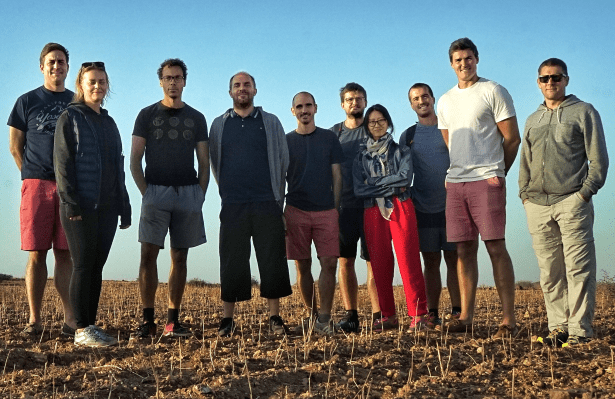
Shipfix, a relatively new startup aiming to drag the dry cargo shipping industry into the digital age, has raised $4.5 million in seed funding.
Leading the round is Idinvest Partners, with participation from Kima Ventures, The Family, Bpifrance and strategic business angels. The company was founded in December 2018 by Serge Alleyne (CEO) and Antoine Grisay (COO), and launched just two months ago.
&We&re trying to fix the email overload for everybody involved in the process of fixing a dry cargo ship by providing a comprehensive market monitor,& Alleyne tells TechCrunch.
&We&re also producing data-driven insights that are profoundly missing in the bulk/break-bulk space. Actually the last revolution of the dry cargo industry was email, and so far people still rely on indices based on a panel of brokers while all the data is available in emails.&
To solve this, Alleyne says that Shipfix connects to its clients& email to extract and anonymously aggregate &billions of data points using deep learning technology.&
The idea is that, rather than spending hours scrolling through your inbox every morning to take the pulse of the market, you can search and filter structured market offers instantly via Shipfix.
In addition, you can browse what Alleyne calls &augmented directories& (ships, ports, companies and people available within emails and signatures — information that isn&t typically available on LinkedIn), and access data-driven benchmarks and indices.
Shipfix customers are primarily anyone chartering/fixing a ship, such as charterers, ship owners, ship operators, freight forwarders and &lots of brokers.&
However, longer term, the startup plans to onboard commodity traders, insurers, banks, governments and investment firms, based on the granular benchmarks and indices it is building.
&We cover 430 cargo categories from salt, sand, iron ore, fertilizers, grain, steel, etc., and forecasting market pressures around the globe… [is useful] for everybody involved within the commodities space,& adds the Shipfix co-founder.
Meanwhile, the company currently employs 15 people, including senior engineers, shipping professionals, data scientists and analysts. The team is mostly remote-based and spread across seven cities, with offices in London, Paris and Toulouse.
- Details
- Category: Technology
Read more: Shipfix raises $4.5M seed for its dry cargo shipping platform
Write comment (95 Comments)Page 14 of 5614

 7
7





